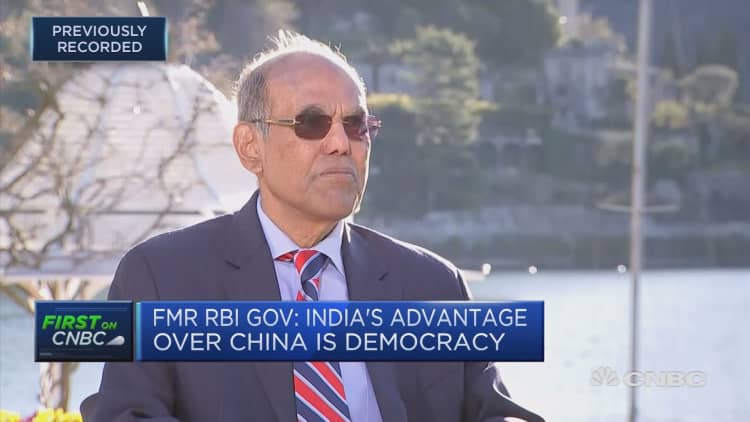
India needs to be — and sustain — the world's next "growth miracle" to fight its poverty problem, according to a former governor of the Reserve Bank of India.
"The tantalizing question is whether India can produce the next growth miracle" after witnessing the same from Japan and China, Duvvuri Subbarao told CNBC's Steve Sedgwick on Friday at the European House Ambrosetti Forum in Cernobbio, Italy.
"In my view it's possible, even probable, but certainly not inevitable," he warned.
"India has enormous poverty," Subbarao said. "In spite of clocking relatively impressive growth rates … India houses more poor people than the entire continent of Africa."
"To get those hundreds of millions of people out of poverty, India needs to produce the next growth miracle," he added.
The latest announcement from India's central bank is a step in this direction. On Thursday, the Reserve Bank of India projected economic growth for the new fiscal year to be 7.4 percent, significantly higher than the 6.6 percent anticipated for the fiscal year which ended in March.
India's supercharged economic growth has made other headlines in recent months, with the country taking the crown as the world's fastest growing major economy for the fourth quarter of 2017. This was 7.2 percent, while Asian rival China clocked in at 6.8 percent.
But the two Asian superpowers — both with populations of over 1 billion — have a fundamental difference.
"One of the big advantages that India has over China is that it's a democracy. And whatever reforms that have been implemented in India have the popular will," Subbarao said. "We believe that there is some support for them."
Indian Prime Minister Narendra Modi's government has implemented two major economic changes within the past 18 months.
In November 2016, the government announced at short notice that 500 and 1,000 rupee notes were to be withdrawn from circulation to crackdown on counterfeit cash. Meanwhile, in July last year India implemented its Goods and Services Tax, a policy overhaul which established a unified tax structure across its states.
Both policy moves were criticized for their chaotic implementation. But, India has gotten past these "bumps" Subbarao said.
"Most analysts believe that after the hit due to demonetization, and the teething problems of GST last year, growth will return to trend," he explained.
"India will be able to sustain (a) 7 percent-plus growth rate if it does all the right things," he said.
India 'certainly' affected by trade wars
With the U.S. and China ratcheting up protectionism and trade tariffs, "India is going to be affected certainly," Subbarao said.
But, he added the caveat that steel and aluminum import duties imposed by the U.S. would have a "limited" impact on India given that its exports of such commodities to the U.S. form only a small part of the whole.
"The first order impact will be quite limited, but if trade wars persist and if protectionist tendencies deepen, India will be affected because exports have to play a big role in India's growth going forward," he reasoned.
Correction: This article has been amended to reflect that India's Goods and Services tax was implemented in July 2017.

